Mahavatar Hariakhan Babaji Maharaj Deathless Saint Of the Himalayas | 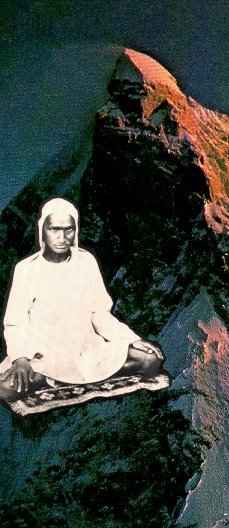 |
Hariakhan Babaji Maharaj
Who was this person called in the West Babaji after his story was first told in Autobiography of a Yogi? Actually the name Babaji is somewhat generic and has been applied to many sages over the years. The word Baba means father and the suffix "ji" is one of respect. But the Babaji written about here is called by many names such as Mahavatar Babaji, Hariakhan Babaji, Babaji Maharaj (great king), Shiva Baba (denoting his close connection to God Shiva), also Bhagavan Sadashiva, Sri Sadashiva, Mahamunindra, and Sri Sri Baba.Hariakhan Baba Maharaj is a Great One, said to have been alive for thousands of years, dwelling in various caves in the Himalayas, appearing sometimes among men to accomplish some particular goal but always watching over the welfare of mankind from the sidelines. Though many people saw him in both the 19th and the 20th century, his appearance was always that of a young man in early manhood. He was tall and slender with a noble and dignified appearance and in nature was humble, kind and childlike. His complexion was light and his hair sometimes worn long and sometimes short. Details of his appearance varied even when he was observed by several people at the same time. He spoke little and seldom ate unless given food by devotees. He never slept, and when on the move, he walked very fast. His appearances and disappearances were always sudden and unexpected. He had great strength of body and was often seen lifting huge rocks. Sometimes he was seen with several Tibetan Lamas and in fact Babaji was often seen wearing a shirt and Tibetan cap over his head. He spoke a mixture of many languages including Nepali, Hindi, and Kurmachal languages. Whenever he talked to anyone from a particular region of India, he spoke to them fluently in their own native language. Nobody knows when he was born or where. He had all the known siddhas (Yogic powers) and occasionally performed miracles in a natural way according to the circumstances at hand. But mostly people were drawn to him because of the bliss they experienced in his presence.
He appeared in many places in Northern India near the Himalayas between 1861 and 1924. At that time he was known by different names in the different regions and people didn't realize these were different names for the same person until a man named Mahendra Brahmachari had a vision of him in 1949. He subsequently became a devotee of Babaji Maharaj and spent thirty-five years traveling all over India, collecting the stories told about encounters with the great Babaji. He published these in India under the title Punya Smriti using the pen name Guru Charnasrit. There was also a book about him titled Hariakhan Baba, Known, Unknown by Baba Hari Dass published in America in 1975 by the Sri Rama Foundation.
The stories that follow are just a few of the many recorded incidents about him and they present different facets of the great master.
- Initial Appearance at Hariakhan Jungle
- Gumani Becomes a True Devotee
- Strange Lights Appear at Siddhashram
- Miraculous Appearance at Katgharia Dedication
- Babaji Punished for Smiling
- The Proper Way to Meet a Saint
- Babaji's Great Disciple Lahiri Mahasaya
Initial Appearance at Hariakhan Jungle
| Around the year 1890, Hariakhan Babaji Maharaj first appeared publicly in a miraculous way and after that he was seen off and on until around 1924. Before and after that period there are accounts of him showing up in one place or another but usually to an individual or a small group. But within that time period, he was seen by thousands of people and the miraculous events that happened spontaneously around him daily were witnessed and recorded widely by people of that time. Many people think he permanently stays in the high mountains of the Himalayas around Nepal and that he appears occasionally to further some specific cause which only he knows. At the foot of the Himalayas in Northern India, there are many small cities and villages that spring up along the many rivers that descend from the Himalayas to the plains of India below. Back then the area was very wild and there were small clearings with villages of just a few hundred people intermixed between large expanses of jungle and forested areas. One such densely wooded area was called the Hariakhan jungle. On the outskirts of the Hariakhan jungle, to the south there was a cluster of houses which was called Hariakhan village. One night the people of the village were astonished when they looked up above the neighboring mountain and saw a single brilliant light shining from the mountain top. The mysterious light reappeared each night for several evenings. Then the same light disappeared from the mountain top and instead appeared near the village itself. The people gathered around to worship the mysterious light and as they came near, they saw a radiant body of divine luster before them. He appeared to be a young man with a pleasant benign face and a reserved dignified nobility about him. The villagers bowed to him and welcomed him with great respect. Because he was first seen by them in the Hariakhan jungle area, he was given the name Hariakhan Baba. The people naturally wanted the saintly Babaji Maharaj to stay with them in their village so they looked about for a suitable place for him to stay. They decided to put him up in the forest guard's house and since this official lived there by himself, it was agreed that Babaji would stay there. The guard, by name Dham Singh, was a very pious man and formed a close attachment to Babaji. Every day he gave Babaji a morning meal and as Babaji would sit quietly unmoving, he developed the habit of locking him within his house before he went off into the forest. He was afraid Babaji would either leave his house or someone would come and take Babaji away to another place. Since Babaji didn't seem to object to this the guard made this his daily routine. After a while some other of the village folk wanted to visit Babaji during the day time while Dham Singh was away on his rounds. They found the house tightly locked up and all the windows were barred so they broke the lock and went inside. But to their surprise, they could not find Babaji anywhere and after this day, he was not seen again by anyone there for over a decade. Then he was suddenly seen again sitting inside a cave in the depths of the Hariakhan jungle. |
| Once in the month of January, Babaji was staying in the Hariakhan cave. A few saints heard about Babaji's yogic powers and decided to have the darshan of the powerful saint. They asked him various questions about Yoga and the scriptures, and then they decided amongst themselves to ask him for a wild fruit called Kaphal that grows only in the Himalayas during the late spring. But in January it is not available. Babaji realized their thoughts, came out of the cave and walked a short distance away. He returned with a branch full of Kaphal fruits and distributed the fruits to the saints. |
Gumani Becomes a True Devotee
At the foot of the Himalayas along the Gautam Ganga River lay the tiny village of Dyola. In this village there lived an illiterate farmer who was called Gumani. Gumani was a very pious person. His wife was expecting a child and after the birth of the child Gumani underwent a strange transformation. He lost all interest in the world and household life and without telling anyone, he joined a group of travelers who were going to the town of Hardwar. There he joined an ashram which was run by a very saintly sanyasin. There Gumani devotedly served the visiting religious pilgrims who came to the ashram. The sanyasin who owned the ashram observed Gumani and was very pleased with his devotion, humility and truthfulness. After a while some visitors came who knew Gumani while he had been a farmer. They recognized him and told the head of the ashram about the situation he had left behind. His wife was very sad and had no one to plant the crops or take care of her or the child.Though the saintly sanyasin had become very attached to Gumani and his services, he realized the suffering his absence was causing and told him to return immediately to his home. But now that Gumani had made the break from his former life the thought of returning was very painful to him. He wept and begged to be allowed to stay, but the saint was firm and told him: "Gumani, go home and live like a hermit there. Meditate and worship God. You will find your guru at your own place."
With great sadness, Gumani returned home and resumed farming as before but with the difference that now his mind was constantly fixed on God.
Then one day when he was returning from his fields he saw a tall slim man with fair complexion standing under a tree near his house. The man was gazing steadily at him. Gumani went closer to him and saw that he had a beautiful radiance about his face and had very peaceful eyes. Gumani was afraid but he summoned the courage to ask: "Maharaj, who are you? Why are you standing here?"
The man was Babaji Maharaj. He knew that Gumani was fearful of him so he walked slowly to the shade of another tree. Then Gumani recalled to mind the words of the saintly sanyasin at the ashram: "You will meet your guru at your own place". So Gumani bowed to his feet and thereafter surrendered himself completely to Babaji.
He took Babaji into his house and began to take care of him with the utmost love and devotion. His body mind and heart were completely dissolved in his service to Babaji Maharaj. Gumani built a hut for Babaji to live in so he would not be disturbed by the rest of the family.
At that time Babaji would take nothing to eat except the liquid whey which was prepared from the milk given abundantly by Gumani's cows. After a while Gumani decided to give up solid food too, and live only on whey just as his guru was doing. The villagers around did not know who Babaji was but because his speech was a mixture of various local languages, they thought him illiterate and somewhat crazy. They wondered why Gumani had taken in such a crazy and illiterate vagabond and also why he was emulating his example by taking only whey. Gumani ignored their remarks but one day he told Babaji very meekly, "Babaji Maharaj, my hunger remains unsatisfied by drinking only whey. I think you too must remain hungry just like me. Why don't you eat food?" When Babaji heard this simple speech full of devotion, he started eating food to fulfill the desire of his devotee.
The villagers continued to regard Babaji as illiterate, stupid and crazy but slowly as they came into closer contact with him they began to sense his greatness and their attitudes completely changed. They began to love him as well and people started to gather at Gumani's house to be in the company of Babaji. Just as he had done at the ashram, Gumani began to take care of all his visitors. Gumani extended full hospitality to the visitors and his wife spent a good part of each day preparing food until, little by little, all his food stores were exhausted.
His wife tried to restrain him from feeding all of the visitors who came to be with Babaji but Gumani continued to give everything he had to them. When there was nothing left in the house to eat, the wife left with her baby to go live with her parents.
Gumani was now alone in his house but he was happy spending all his time serving Babaji Maharaj. Babaji too felt great love for his disciple. This continued for a year and then Babaji left to go to Almora. Gumani was now all alone in his house, with no wife or friends and not even any food stores or money left. He spent his time meditating on God or walking around his barren fields.
One day as he was walking across his fields, he saw a man with a plow across his shoulders and was immediately reminded of the Avatar Krishna's brother Balaram, who had also carried a plow across his shoulders in the same manner. For Gumani, everyone was God, and when the man came near, he bowed to his feet with much reverence and devotion.
The man stepped back with great surprise saying, "What are you doing? I am a poor laborer, wandering in search of a job. Why are you bowing to my feet?"
Gumani replied, "You are my Lord Balaram, don't try to fool me. For me you are no less than God."
The man said, "I have no house and no place to live. I am a very poor man. Believe me, I am searching for a job".
So Gumani asked the man to come live in his house with him and told him he was welcome to stay as long as he liked. Gumani felt that the man had come to his house by the order of God, and he therefore served him with great respect and devotion.
The rainy season was approaching and the man saw from the house that the land around had not yet been tilled or planted. He told Gumani he did not like to sit idle and would like to till his land for him. Gumani accepted his offer as God's desire and allowed him to do as he wished. Then the man plowed the land and sowed grain upon the fields. After completing the sowing, he disappeared from Gumani's house.
When harvest time arrived it was found that the grain collected was more than fifty times what had been collected in past years. The entire house was filled with rice and there was rice in the granary as well. Seeing the plentiful crop, Gumani realized that the man who had sown his fields was none other than Babaji Maharaj himself, who had chosen to repay him for the grain Gumani had offered in serving Babaji's devotees.
When Gumani's wife heard about the remarkable crop of rice in her fields she was very surprised and returned home to Gumani's house with her son.
Gumani marked the years as they passed waiting for Babaji to return but after five years he decided that he should instead go looking for Babaji Maharaj. So he left immediately for Almora determined to live with him and serve him for the rest of his life. When after five years of separation Gumani was once again reunited with his master he burst into tears and dropped to the ground at his feet. Babaji told him he was just leaving to visit the Badrinath temple high on a peak in the Himalayas, and he invited Gumani to go with him. Gumani was very happy to be invited along on such an auspicious religious pilgrimage and readily agreed to go.
Word got out of the pilgrimage and two men showed up and asked to go along. Babaji neither agreed nor refused to take them but kept his silence. When it was time to go, the men followed along behind them nevertheless. As the road got steeper it turned into a narrow trail until after a while they were treading along a ledge with a sheer rock wall on one side, and a deep precipice on the other. Babaji was walking rapidly ahead with Gumani and the two men further back behind him. Suddenly a huge lion came into view blocking the three men's path. The lion had it's tail raised up in a most furious manner. The men told Gumani they should make a hasty retreat but without waiting to see if he was with them, they turned around and ran back the way they had come.
Gumani remained there, wanting to continue on after his master. Soon the lion grew calm, laid down and paid no more attention to him. He quietly stepped around it without hesitation or fear and caught up to Babaji. They continued on the steep path until they finally reached the Badrinath temple at the top where they worshipped, and then turned around and returned back to Almora.
Babaji now told Gumani to return to his village and look after his family and to continue on with his meditation and worship. Although Gumani did not want to leave his beloved guru, he followed his order and returned back to his home and family. There he performed his worldly duties and his meditations as he had been obstructed. After one year he left his body in peace.
By the grace of Babaji Maharaj, the illiterate and simple Gumani had become a true devotee of God and his story and reputation spread throughout the region. The hut that Gumani had built for Babaji to stay in is still preserved today in his native village
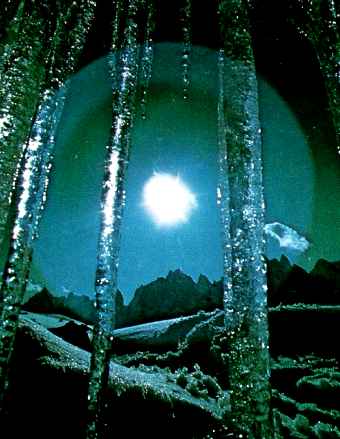 | A man who was well versed in religious scriptures once came to Babaji Maharaj and wanted to know what was meant by the "cosmic body of God." Babaji rarely spoke and characteristically kept his silence and continued to sit quietly. But after a while he said: "Close your eyes and worship God for some time, and then open your eyes." The man did as he was instructed. He closed his eyes and meditated on God for a while and then opened his eyes. As he looked around, everywhere he looked he saw Babaji Maharaj and everything he saw became Babaji Maharaj. Then Babaji said quietly: "No one can really define God by reading the scriptures." |
Strange Lights Appear at Siddhashram
Besides staying in the Hariakhan area, Babaji also spent some time near the town of Almora. While he was staying there he asked some disciples where he might find a source of cold pure water. The devotees led him into a jungle area where there was a spring flowing slowly, drop by drop providing a small supply of cold water. Babaji pushed his finger into the area where the water was seeping and the water started gushing out in a steady stream. Because of the beauty of the place and the source of pure spring water, Babaji wanted to set up an ashram there. Some nearby villagers gave him some land and people started gathering at the new ashram which Babaji Maharaj called Siddhashram. The devotees would gather during the day to be with Babaji and at night return to their village homes. One night a devotee named Siromani Pathak stayed all night sleeping with Babaji in the hut that had been built for him. In the middle of the night, Babaji woke the devotee up and told him to look in the direction of the spring. When he did Siromani Pathak saw what appeared to be four bright flames of light hovering near the stream of water. The whole area was lit up by the light emanating from the flames. The flames lasted for some time and then disappeared. When Siromani asked Babaji about the lights he was told that because the place was very sacred, various gods came to the spot and were visible in the form of lights. Other people said that they too had sometimes seen strange lights in the presence of Babaji and they felt that they were very high saints coming to pay their respects.| Once Maharaja Sindhiya, the king of Gwalior invited Babaji to come to his palace so that he and his wife might have his darshan. Babaji agreed and the king and his ministers met with him at the house of a local pandit. Then Babaji went to the queens palace and gave her darshan separately from the king. After Babaji left, the king wanted to talk to his queen about their encounter with the high saint. It came out in conversation that the queen had guessed Babaji to be around eighty years old but the king said he had appeared to him to be a youth of around eleven years. It was a common occurrence that Babaji would appear differently to different people. |
Miraculous Appearance at Katgharia Dedication
For a while, Babaji Maharaj lived in a jungle called Kalichaur. The jungle was called this because there was a life size statue of the mother goddess Kali there carved in black stone. The jungle was full of wild and dangerous animals like snakes, tigers and wild elephants. Babaji lived in the jungle but would sometimes walk along the river banks or cross to the other side of the river to a village called Katgharia.Wherever he went the news went out that he was present and people would gather around him. His very presence filled the area with his purity and supernatural powers. People would forget their cares, pains, and miseries and become happy like children in his presence. Whenever the people congregated in this manner around him, they would spontaneously organize spiritual functions such as sacred singing (bhajan), feeding of the poor, or the burning of a sacrificial fire (yajna). Sometimes thousands of people would show up in Katgharia from neighboring villages to enjoy the spiritual festivities and return to their homes full of joy and happiness.
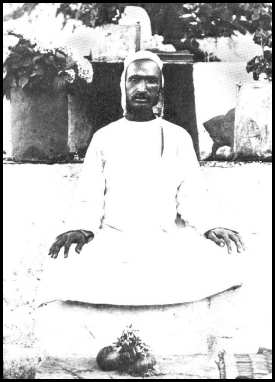 Once an English commissioner was passing through Katgharia and observed the huge crowd that had gathered around the saintly figure of Babaji. He saw the spiritual glow emanating from the face of Babaji and he felt peace and happiness welling up within himself. He got down from his horse and went near to get a better look at him. Babaji directed his gaze at the man and for a while the man stood transfixed as if hypnotized.
Once an English commissioner was passing through Katgharia and observed the huge crowd that had gathered around the saintly figure of Babaji. He saw the spiritual glow emanating from the face of Babaji and he felt peace and happiness welling up within himself. He got down from his horse and went near to get a better look at him. Babaji directed his gaze at the man and for a while the man stood transfixed as if hypnotized. Later the man asked who Babaji was and he was told he was a very high saint who possessed supernatural powers. The commissioner was so impressed that he decided to donate a large plot of land in Babaji's name. The devotees built a temple and a small residence on the land. Many years later, after Babaji was no longer seen in the area, Sri Mahendra Brahmachari decided to build a large ashram dedicated to Babaji's memory. It was he who had taken it upon himself to collect Babaji's stories from all over the Indian countryside. Finally in 1958, the ashram construction was complete and a huge gathering had been invited to celebrate the opening. People had gathered from India as well as western countries and activities such as sacred music and fire ritual were being conducted. Food was distributed to everyone who attended. As the fire ritual (yajna) was in progress and people were singing or eating suddenly a divine light manifested itself and a celestial form was seen hovering a few feet above the ground. The form of Hariakhan Babaji Maharaj clad in the familiar shirt and Himalayan cap was recognized. A wave of joy went through the crowd and people began to dance ecstatically. Some lost consciousness through sheer emotion of the moment.
A few years after this incident, the Kadamba tree where Babaji used to sit sprouted a small Pipal tree and then a Banyan tree. Now three auspicious trees are growing from the same trunk. It is said that those particular trees represent the three major forces (gunas) of the universe. The tree is now worshipped with great devotion.
| At one time a solar eclipse was predicted. Because of the auspicious occasion, many people in the small town of Ranibag planned to take a dip in the River Gatum Ganga which ran along the outskirts of town. Babaji Maharaj happened to be staying there near the Shiva temple. As generally happened in his presence a large group had gathered, anxious for the chance to take part in the ceremonial bath along with Babaji during the eclipse. A group of others had already planned to bathe at Kurukshetra where the famous battle recorded in the Mahabharata had taken place long ago. That place was made even holier as the site where the Avatar Krishna had delivered his discourse to his companion Arjuna as recorded in the Bhagavad Gita. As it turned out, part of the group remained in Ranibag and the other part proceeded to Kurukshetra. When the moment of the eclipse arrived, the group that had gone on to Kurukshetra were amazed and delighted to see Babaji in their midst, wading into the River Ganga along with them. When the group returned back to their homes in Ranibag, they were surprised to see that Babaji Maharaj had already arrived back from Kurukshetra. They asked the others when he had returned and were told that he had never left. He had remained in Ranibag to bathe with the people that had stayed behind. Thus they came to know that he had satisfied both groups by being simultaneously present in both places. |
| In 1911 Babaji Maharaj went to the city of Prayag and was seen by many people bathing in the river at one of the public baths. A photographer named Sorabji took two pictures of him while he was there. To everyone's surprise, when the pictures were developed, in one Babaji was wearing his shirt and tibetan cap, and in the other he was wearing no clothes at all. This even though both pictures were taken at the same time. The two pictures are shown below. | |
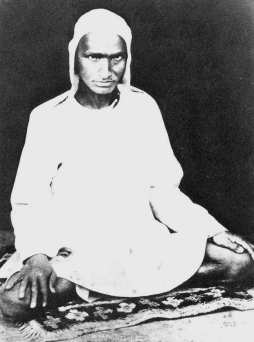 | 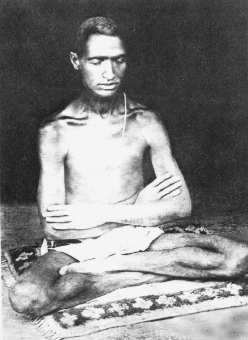 |
Babaji Punished for Smiling
During the summer of 1914, Babaji Maharaj had enlisted to help in the building of some military barracks in the Ranibag area. On many occasions he was seen working on projects such as this as an ordinary laborer. The workers were carrying rocks on their heads moving building materials by hand.At that time, the Minister of Education, one Pandit Jwala Datt of Almora happened to be passing through the area in his horse cart, on his way back to his home town. As he passed the line of laborers, he saw one of the men smiling at him. He was incensed that a mere laborer would act so familiarly with a man of his position. So he instructed his secretary to tell the laborer that he would be punished for his rude behavior. The secretary confronted the worker but the worker, who was of course the saintly Babaji, seemed completely unruffled. He merely told the secretary that he was smiling because the bell of the Badrinath temple had fallen down and many people were there trying to raise if back up again but there efforts were not working. Pandit Jwala Datt became even angrier at this and vowed to inflict his punishment if the story proved to be a lie. So he sent off a telegram to distant Badrinath to find out if the incident had happened. The reply came back confirming that the bell indeed had fallen down and people were trying to raise it back up.
Pandit Jwala Datt was humbled by the experience and baffled by the apparent omniscience of the saint posing as an ordinary laborer. This event completely changed his outlook on life. Before he had been learned but egotistical. Now he became humble and very devoted to Babaji. He spent the rest of his life in religious devotion.
| Babaji took a job as a laborer when the dam at Lake Bhim Tal was being constructed. There had been several previous attempts to build a dam at the same location but they had all failed. But this time, with Babaji present, the construction was successful. For a time none knew his identity but after a while some people recognized the famous saint and shortly after that he disappeared. |
The Proper Way to Meet a Saint
Near Nainital at the foot of the Himalayas there is a lake called Khurpatal. At the site of the lake, a village had sprung up and the people there planted gardens and sold produce in neighboring Nainital for their livelihood. Babaji Maharaj occasionally would stay in this quiet town along the placid lake and people from the region would visit to enjoy the blessings of his noble and loving presence.Once while he was staying there a well educated young man learned of his presence and began to wonder about his identity. It was well known that Babaji had appeared to people unexpectedly in various places at widely scattered intervals of time. He was believed to be centuries old and quite a few thought he had been present for thousands of years. This man had heard that Babaji had been present at the battle of Kurukshetra which took place over 5,000 years ago. He reasoned that Babaji must really be Aswathama, one of the immortal warriors that had taken part in the battles. In the Mahabharata it is recorded that Aswathama was wounded on the top of his head and so the man concluded that this was probably the reason why Babaji Maharaj was habitually seen wearing a Tibetan cap or some other form of head covering.
The man was excited to prove his theory so he proceeded to Khurpatal and sought out the presence of Babaji. As soon as Babaji saw the man he informed him that as it was very hot, he was going to bathe in the cool waters of the lake and so he requested the man to help him by carrying his possessions to the edge of the lake. The man was very happy at this because he knew that Babaji would remove his cap before entering the water and thus he could verify whether his suspicions were true.
As they stood at the edge of the lake, Babaji asked the man to help him off with his clothes. As soon as the man touched Babaji, he was filled with an inexpressible bliss. In an ecstatic mood he helped Babaji into the water, bathed him and then dried and redressed him. As they were returning to the hut where Babaji was staying the man realized with great chagrin that in his blissful state he had completely forgotten to look for scars on the top of Babaji's head.
But Babaji knew his thoughts all along and said to the man with great equanimity, "Whenever you go to meet a saint or high spiritual soul, go with much devotion and faith. If you have any doubts, ask him for their clarification. Only those who are blessed by God can recognize a saint. Those who have a pure heart and those who are humble and egoless attain the grace of saints."
The man then realized the omniscience of the saint and instantly became a true devotee.
| In the winter of 1952 Baba Hari Dass was living in a room attached to a cave near a burial ground by the name of Ghati. The room was very cold in the winter and so he kept a fire burning inside the cave and meditated sitting close to the fire. It happened one time that as he was meditating, he lost consciousness and his body slumped to the left and his arm fell into the fire pit. When he came to awareness he saw the tall figure of Babaji Maharaj bending over him and removing his arm from the vicinity of the flames. Without a word, Babaji turned and left as quickly as he had come. Baba Hari Dass jumped up quickly in order to catch up with Babaji and bow to his feet but when he stepped outside Babaji had disappeared. |
Babaji's Great Disciple Lahiri Mahasaya
One of the earliest appearances of Babaji was documented by one of his most important disciples, the great saint and yogi, Sri Shayama Charan Lahiri Mahasaya. Lahiri Mahasaya was born in 1828 and while growing up he was taught several languages including Sanskrit. As a young man he closely studied the vedas and eagerly listened to discussions of learned brahmins. Lahiri was full of good qualities and well liked by everyone around him. By the age of 33 he had married and gotten a government post and received news that was to change his life. He was told to report to the city of Rhanikhet which sits at the foot of one of the highest Himalayan peaks, Nanda Devi. Once there he was immediately taken with the beauty of the Himalayan foothills and spent his evenings hiking high up into the mountain fastnesses. One day while he was hiking he heard his name being called and followed the voice high up to a clearing surrounded by small caves. There he saw Babaji Maharaj who addressed him familiarly by name and welcomed him after his long absence. Although Lahiri didn't know who he was he felt drawn to his presence. Babaji explained that in Lahiri's former life, he had been his guru and that Lahiri had been his advanced disciple, meditating for decades under his guidance in one of the caves that surrounded the mountainous ledge. With a touch to his forehead, Babaji awakened his memory of that past life they had spend together. Then Babaji induced in him the highest or Nirvikalpa state of Samadhi in which the individual wave merges with the Universal ocean of consciousness and attains the state of Cosmic Consciousness. Lahiri remained in unbroken samadhi for seven days and then Babaji brought him back to his human awareness and explained to him that Lahiri Mahasaya had taken his present birth for a purpose and that he was to be instrumental in spreading the Yogic teachings of union with God to the greater world beyond the borders of India.Lahiri Mahasaya was given the task of setting the example of the ideal Yogi householder, maintaining job and family and living in the world, yet remaining peacefully poised in the bliss of inner awareness. The perfume of his spiritual greatness attracted dozens of followers. Lahiri spontaneously developed many siddhis or yogic powers and these further enhanced the faith and devotion of his many disciples. According to Babaji, Lahiri Mahasaya was to be instrumental in bringing East and West together. This he did through the agency of his direct disciple Sri Priya Yukteswar Giri who in his turn was the Guru of Paramahansa Yogananda, well known in the West as the author of Autobiography of a Yogi. The disciple, Sri Yukteswar, wrote a treatise showing the parallels between the Christian (Western) and Hindu (Eastern) religions. At the urging of Sri Yukteswar, Paramahansa Yogananda in his turn moved to the West to California and introduced much of America to the Eastern Yogic science of union with God, independent of any specific religion. Thus was the practicality of the West blended together with the spirituality of the East. All this was foretold by Babaji in his initial meeting with Lahiri Mahasaya in 1861.
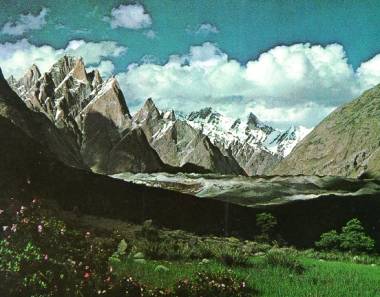 <---Back to Cosmic Harmony Home Page |















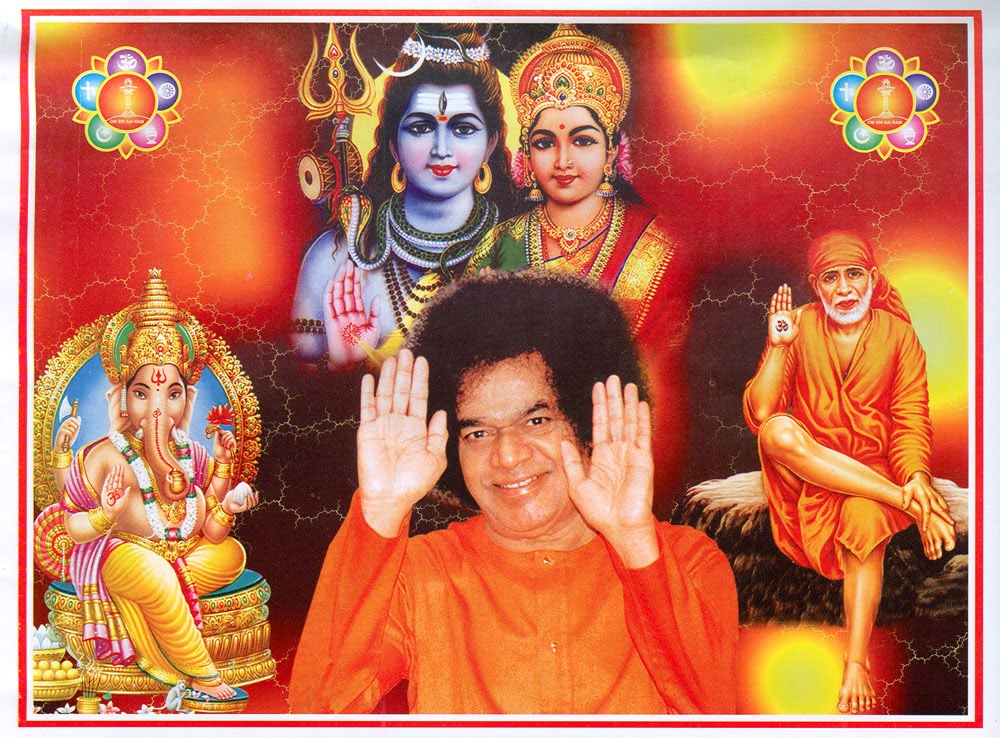







No hay comentarios :
Publicar un comentario